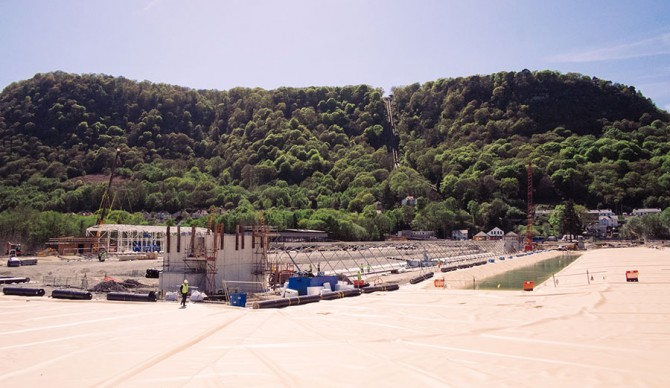Each day we inch closer to the reality of artificial waves becoming monotized and readily available to the public. Wavegarden’s technology, with their test facility in Spain, has been shared widely over the past two years but details about the proceeding commercial parks in Snowdonia, North Wales and now Austin, Texas have remained relatively under the radar. Until now.
Surf Snowdonia offered a detailed press release this week, mainly geared toward explaining the Wavegarden technology they’ll employ to power head high waves with mechanical precision every 30 seconds. We all already know the wave itself is going to be fun as hell. We’ve seen videos of Carissa Moore, Lakey Peterson, Mick Fanning, and plenty of others having their fun on 4 foot waves in the Basque Country’s test facility, and have been given the breakdowns on how these waves are created. This is expected to be the first cost efficient and energy efficient way to produce waves sustainable to operate giant theme parks and hosting thousands of people at a time. And that’s led to another conversation altogether: How environmentally friendly can an artificial wave, and all the bells and whistles at its accompanying theme park be? Putting hordes of people into one space, feeding them, parking their cars in a large space, the list goes on – it doesn’t exactly sound like the greenest of business ventures. So these were the details I looked for in Surf Snowdonia’s release, realizing my own day to day hunt for waves isn’t very eco-conscious itself. I drive an SUV, and unless it’s really good down the street from my home I’m likely getting in that SUV to go find waves more than 15 minutes away. I take good enough care of my wetsuits and boards to not have to replace them multiple times a year, so I guess I get a pat on the back for minimizing my footprint in two highly toxic processes. But I’m still not exactly recycling my yoga mats to make my next pair of flip flops. And neither are you, most likely. I’m thinking all these things while I read the following details about Surf Snowdonia’s plans for an environmentally conscious park.
First off, Surf Snowdonia is physically being transformed from a former aluminum quarry and open to the public by August 1st. Over 25,000 cubic meters of material from the original site have been crushed and is being re used as part of the current park’s construction. That’s along with more than 400 tons of steel, cast iron and copper that are being recycled as well. The lagoon itself will be filled with rainwater from nearby mountain reservoirs, cleaned using UV disinfection and filtration, creating a self-sustainable, chlorine-free water supply. “Our agile approach has required close collaboration between mechanical, geotechnical, hydrological, civil and structural engineers. Our common determination to deliver ‘excellence’ has allowed us to stay on schedule and on budget. The sense of genuine excitement that comes with working on a world-first engineering project is palpable,” says Managing Director at Cal Ltd, Steve Davies.
They’re all details that could be otherwise ignored in the construction of another commercial theme park, were it not born through surfing. To think of a literal wasteland, holding man’s excess for decades, now being turned into a playground is something to be excited about. It’s a playground that will attract more than 75,000 visitors each year, with up to 52 surfers in the water at a time. That’s going to leave a large footprint pretty fast, so yes, these are important details to know as we inch closer to artificial waves driving surf tourism, and ultimately more consumption in the name of riding waves.


